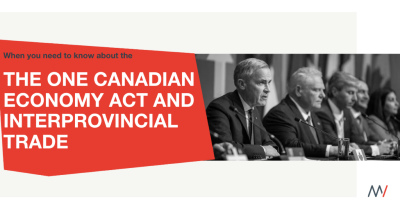AI is not a sector – it is a systems transformation requiring an innovation policy shift
By Andrew Maxwell
 Dr. Andrew Maxwell is the Bergeron Chair in Technology Entrepreneurship in the Lassonde School of Engineering at York University.
Dr. Andrew Maxwell is the Bergeron Chair in Technology Entrepreneurship in the Lassonde School of Engineering at York University.
When Prime Minister Mark Carney appointed Evan Solomon as Canada’s first Minister of Artificial Intelligence and Digital Innovation, Carney rightly signalled that the age of AI is upon us.
Yet Carney’s sweeping mandate letter offers only vague nods to the role AI will play in government transformation. Worse still, there is no specific mandate for Solomon – despite the fact that he presides over the most structurally transformative tool we’ve encountered in a century.
The omission is not a mere bureaucratic oversight. It reveals a deeper issue: we continue to treat AI as a standalone “tech issue” when in fact it is a horizontal capability – one that will transform how government operates, how citizens are served, and how the economy functions.
Let’s be clear: AI is not a sector, it is a system-level enabler. Its potential lies not in building more AI startups (though that matters too), but in transforming healthcare delivery, revolutionizing education, boosting productivity in the public and private sectors, and rethinking how we govern.
To do that, the locus of innovation policy must shift – from siloed digital strategies to integrated, domain-specific deployments of AI in every corner of government and society.
Recent federal strategies – including the AI Strategy for the Federal Public Service and the Pan-Canadian Artificial Intelligence Strategy – signal intent, but both fall short of embracing AI as a lever for systems-level redesign. The former emphasizes responsible adoption within departments; the latter, commercialization and talent pipelines.
Neither strategy tackles the behavioural and institutional redesign required to move beyond efficiency into structural innovation.
We need to stop framing AI as a technological upgrade and start treating it as a catalyst for public sector reinvention.
Real value of AI lies in deployment, not just discovery
Canada’s AI narrative has long been dominated by its early successes in deep learning research, commercial ventures like Cohere and institutes like the Vector Institute in Toronto. While this research strength is a national asset, our policy response risks becoming one-dimensional: building “AI companies” instead of building an “AI-powered society.”
As Geoffrey Hinton and others have long argued, the real value of AI lies in deployment, not just discovery.
The federal public service strategy does document some promising applications – from Immigration, Refugees and Citizenship Canada’s use of AI for case triage, to Shared Services Canada’s internal chatbot, to Innovation, Science and Economic Development Canada’s transcription tools.
But these are isolated deployments. They are not part of a coordinated systems shift.
The Pan-Canadian AI Strategy, meanwhile, is focused on talent, standards and commercialization. It reflects a traditional innovation model: invest in R&D, create pathways to commercialization, and hope the market takes care of the rest. That model underestimates the complexity of AI’s integration in real systems, particularly public ones.
We have no clear national strategy for sectoral deployment. No mandate for AI in healthcare diagnostics or education design. No systemic investment in public sector upskilling. No behavioural innovation to accompany technological capability.
AI innovation policy lives in the intersection and requires clear ownership
Effective AI policy must be developed at the intersections – between health and AI, education and AI, and public service and AI. Without a grounding in sectoral use cases, generic AI innovation policy will always underperform.
Productivity growth, a core theme in Carney’s letter, will not come from generalized tech enthusiasm. It will come from embedding AI in operational systems – triage, diagnostics, curriculum design, energy efficiency, procurement and taxation.
And yet, who in Ottawa owns this transformation?
The new public service strategy proposes a Centre of Expertise, ethics boards, and lighthouse projects. These are useful governance steps. But they do not solve the real challenge: fragmented ownership, unclear mandates, and jurisdictional overlap. Unlike physical infrastructure, where responsibility is defined and investment models are mature, digital infrastructure (especially AI) lacks a deployment strategy.
Carney has called for “AI at scale,” but scale without a policy engine is just rhetoric.
A fundamental tension: AI meets social systems
There is a deeper epistemological divide we must recognize. AI is rooted in physical and computational sciences – quantitative, predictive, and fast-moving.
Innovation policy, by contrast, is a social science – governed by trust, human behaviour, equity, and ethics.
The result? A constant tension between what is technologically possible and what is societally acceptable. This divide is why bold digital innovation strategies often die quiet deaths in policy circles.
To bridge this gap, we need leadership that understands both languages – and the courage to experiment responsibly in public systems.
The federal strategy acknowledges the need for culture change and workforce development. But retraining is not enough. We need behavioural transformation: new incentives, new performance frameworks, and new narratives of value.
When Dalton McGuinty appointed himself as Ontario’s Minister of Research and Innovation in 2005, he sent a message: innovation was too important to delegate.
Carney would do well to consider the same. Delegating AI and digital innovation to a new minister with no domain expertise but high visibility risks symbolic leadership when we need structural reform.
If Carney is serious about deploying AI at scale, his government must go beyond market regulation and into systems redesign. It means developing mission-oriented AI adoption strategies, making digital readiness a pillar of federal-provincial transfers, and building AI literacy and behavioural capacity in the public sector workforce.
Canada has talent. It has research. It even has decent funding. What we don’t yet have is a plan – one that recognizes AI as the nervous system of modern government, not just another widget in the tech industry.
That’s the real mandate Evan Solomon should have been given.
R$
| Organizations: | |
| People: | |
| Topics: |
Events For Leaders in
Science, Tech, Innovation, and Policy
Discuss and learn from those in the know at our virtual and in-person events.
See Upcoming Events
You have 0 free articles remaining.
Don't miss out - start your free trial today.
Start your FREE trial Already a member? Log in
By using this website, you agree to our use of cookies. We use cookies to provide you with a great experience and to help our website run effectively in accordance with our Privacy Policy and Terms of Service.





